BUSN20016 Research Proposal: Brand Image Impact on 7-Eleven
VerifiedAdded on 2023/01/17
|7
|1099
|74
Report
AI Summary
This research proposal investigates the critical impact of brand image on organizational success, using 7-Eleven as a case study. The study aims to examine the elements of brand image and how it influences the success of an organization, with the specific objectives of evaluating the impact of brand image on 7-Eleven, and recommending strategies for effective brand image development. The methodology includes a literature review of relevant journals and articles, employing a positivism research philosophy and a descriptive research design. Data collection involves both qualitative and quantitative methods, including surveys and interviews. A random probability sampling method will be used with a sample size of 20 customers and 4 managers. The proposal also addresses ethical considerations and acknowledges potential limitations. The research is designed to provide insights into how 7-Eleven and similar organizations can improve their brand image and overall performance.
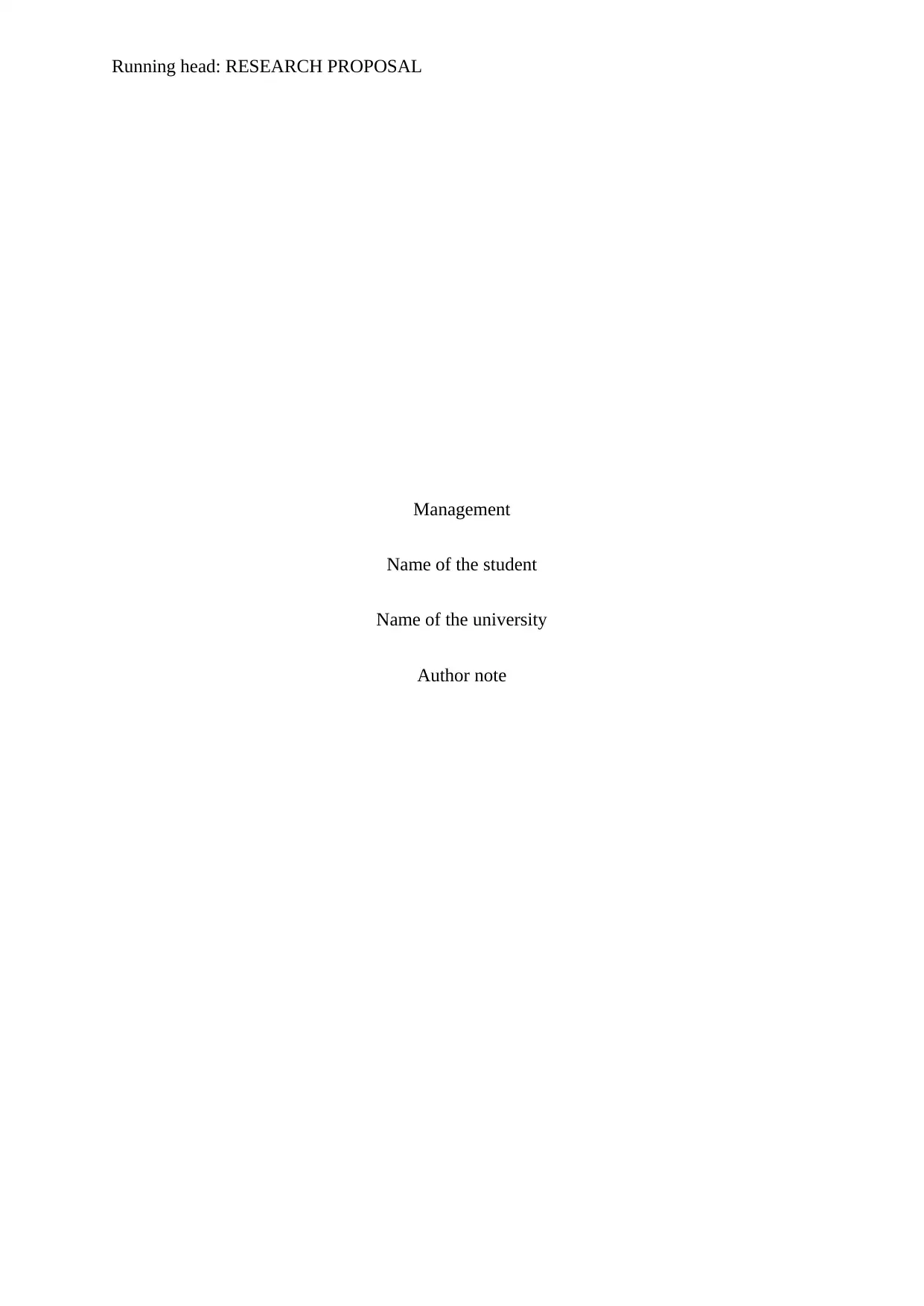
Running head: RESEARCH PROPOSAL
Management
Name of the student
Name of the university
Author note
Management
Name of the student
Name of the university
Author note
Paraphrase This Document
Need a fresh take? Get an instant paraphrase of this document with our AI Paraphraser
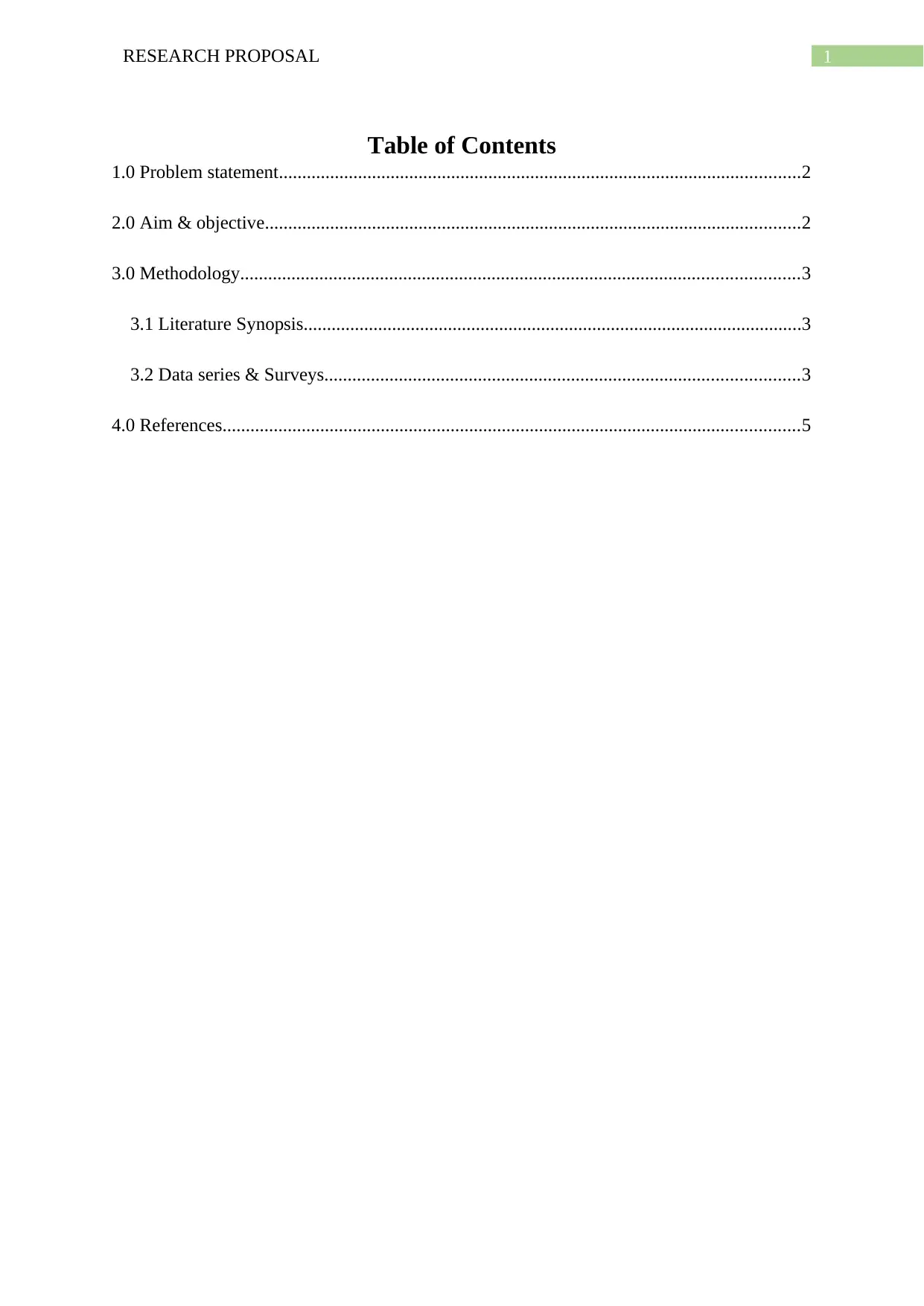
1RESEARCH PROPOSAL
Table of Contents
1.0 Problem statement................................................................................................................2
2.0 Aim & objective...................................................................................................................2
3.0 Methodology........................................................................................................................3
3.1 Literature Synopsis...........................................................................................................3
3.2 Data series & Surveys......................................................................................................3
4.0 References............................................................................................................................5
Table of Contents
1.0 Problem statement................................................................................................................2
2.0 Aim & objective...................................................................................................................2
3.0 Methodology........................................................................................................................3
3.1 Literature Synopsis...........................................................................................................3
3.2 Data series & Surveys......................................................................................................3
4.0 References............................................................................................................................5
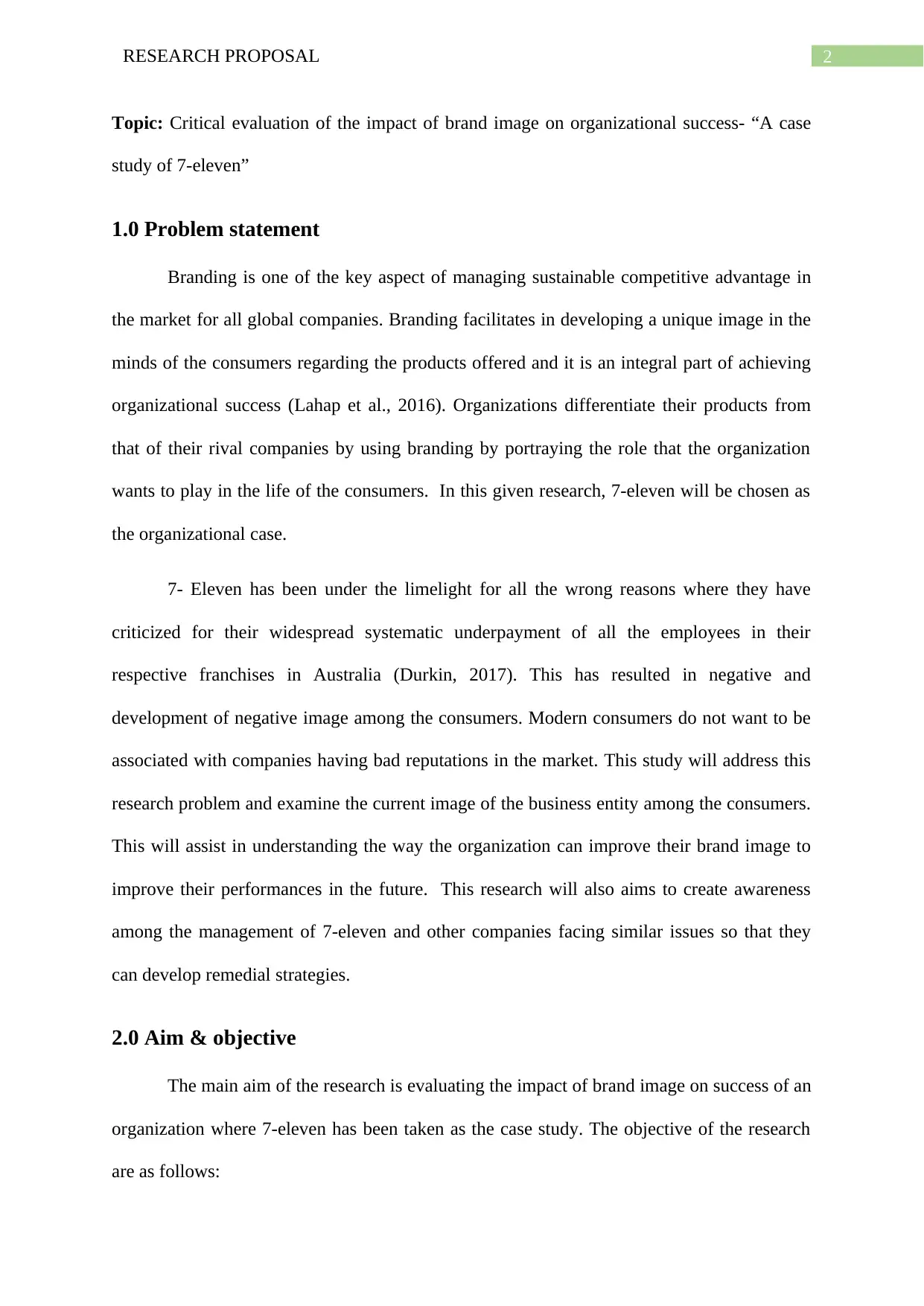
2RESEARCH PROPOSAL
Topic: Critical evaluation of the impact of brand image on organizational success- “A case
study of 7-eleven”
1.0 Problem statement
Branding is one of the key aspect of managing sustainable competitive advantage in
the market for all global companies. Branding facilitates in developing a unique image in the
minds of the consumers regarding the products offered and it is an integral part of achieving
organizational success (Lahap et al., 2016). Organizations differentiate their products from
that of their rival companies by using branding by portraying the role that the organization
wants to play in the life of the consumers. In this given research, 7-eleven will be chosen as
the organizational case.
7- Eleven has been under the limelight for all the wrong reasons where they have
criticized for their widespread systematic underpayment of all the employees in their
respective franchises in Australia (Durkin, 2017). This has resulted in negative and
development of negative image among the consumers. Modern consumers do not want to be
associated with companies having bad reputations in the market. This study will address this
research problem and examine the current image of the business entity among the consumers.
This will assist in understanding the way the organization can improve their brand image to
improve their performances in the future. This research will also aims to create awareness
among the management of 7-eleven and other companies facing similar issues so that they
can develop remedial strategies.
2.0 Aim & objective
The main aim of the research is evaluating the impact of brand image on success of an
organization where 7-eleven has been taken as the case study. The objective of the research
are as follows:
Topic: Critical evaluation of the impact of brand image on organizational success- “A case
study of 7-eleven”
1.0 Problem statement
Branding is one of the key aspect of managing sustainable competitive advantage in
the market for all global companies. Branding facilitates in developing a unique image in the
minds of the consumers regarding the products offered and it is an integral part of achieving
organizational success (Lahap et al., 2016). Organizations differentiate their products from
that of their rival companies by using branding by portraying the role that the organization
wants to play in the life of the consumers. In this given research, 7-eleven will be chosen as
the organizational case.
7- Eleven has been under the limelight for all the wrong reasons where they have
criticized for their widespread systematic underpayment of all the employees in their
respective franchises in Australia (Durkin, 2017). This has resulted in negative and
development of negative image among the consumers. Modern consumers do not want to be
associated with companies having bad reputations in the market. This study will address this
research problem and examine the current image of the business entity among the consumers.
This will assist in understanding the way the organization can improve their brand image to
improve their performances in the future. This research will also aims to create awareness
among the management of 7-eleven and other companies facing similar issues so that they
can develop remedial strategies.
2.0 Aim & objective
The main aim of the research is evaluating the impact of brand image on success of an
organization where 7-eleven has been taken as the case study. The objective of the research
are as follows:
⊘ This is a preview!⊘
Do you want full access?
Subscribe today to unlock all pages.

Trusted by 1+ million students worldwide
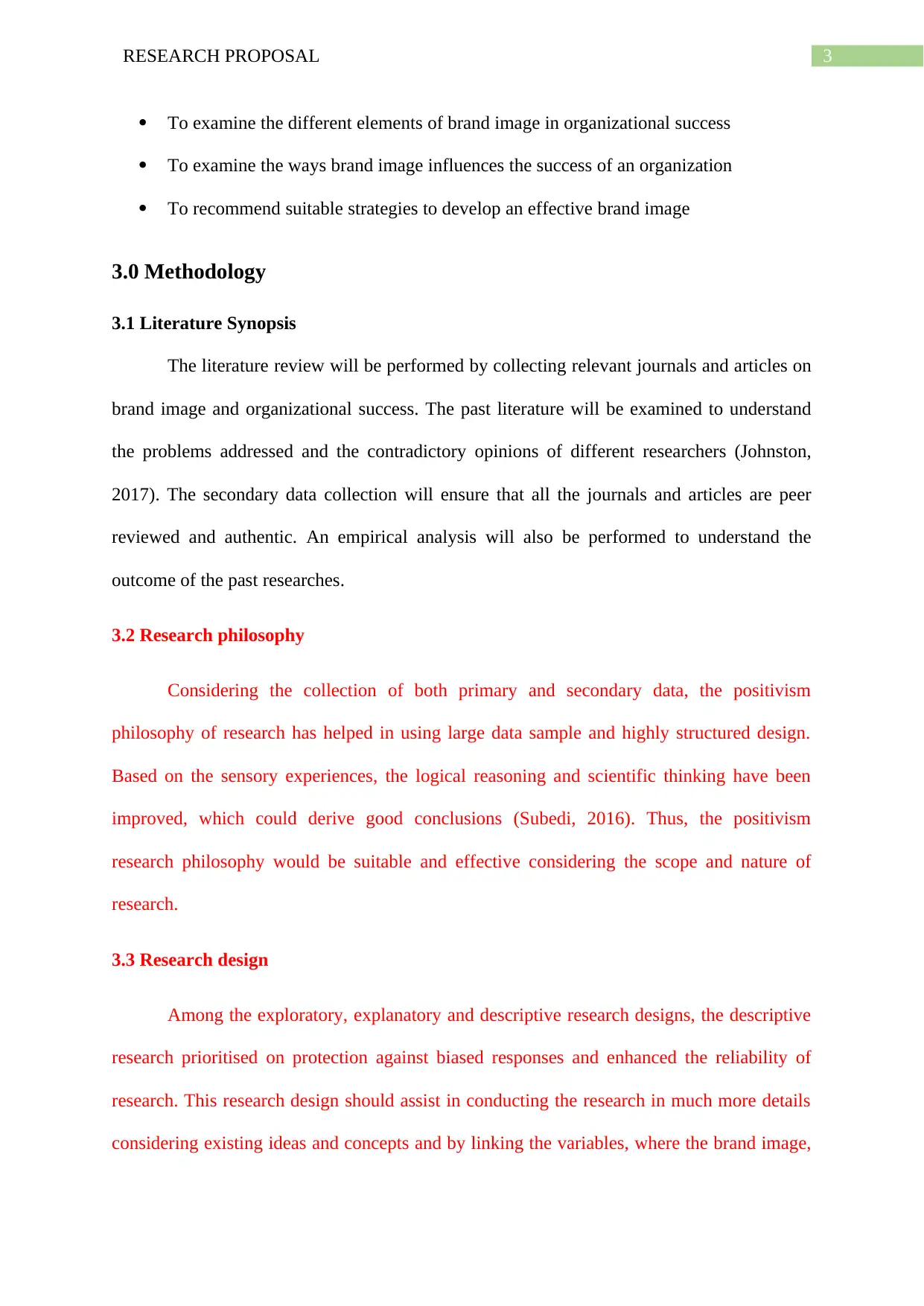
3RESEARCH PROPOSAL
To examine the different elements of brand image in organizational success
To examine the ways brand image influences the success of an organization
To recommend suitable strategies to develop an effective brand image
3.0 Methodology
3.1 Literature Synopsis
The literature review will be performed by collecting relevant journals and articles on
brand image and organizational success. The past literature will be examined to understand
the problems addressed and the contradictory opinions of different researchers (Johnston,
2017). The secondary data collection will ensure that all the journals and articles are peer
reviewed and authentic. An empirical analysis will also be performed to understand the
outcome of the past researches.
3.2 Research philosophy
Considering the collection of both primary and secondary data, the positivism
philosophy of research has helped in using large data sample and highly structured design.
Based on the sensory experiences, the logical reasoning and scientific thinking have been
improved, which could derive good conclusions (Subedi, 2016). Thus, the positivism
research philosophy would be suitable and effective considering the scope and nature of
research.
3.3 Research design
Among the exploratory, explanatory and descriptive research designs, the descriptive
research prioritised on protection against biased responses and enhanced the reliability of
research. This research design should assist in conducting the research in much more details
considering existing ideas and concepts and by linking the variables, where the brand image,
To examine the different elements of brand image in organizational success
To examine the ways brand image influences the success of an organization
To recommend suitable strategies to develop an effective brand image
3.0 Methodology
3.1 Literature Synopsis
The literature review will be performed by collecting relevant journals and articles on
brand image and organizational success. The past literature will be examined to understand
the problems addressed and the contradictory opinions of different researchers (Johnston,
2017). The secondary data collection will ensure that all the journals and articles are peer
reviewed and authentic. An empirical analysis will also be performed to understand the
outcome of the past researches.
3.2 Research philosophy
Considering the collection of both primary and secondary data, the positivism
philosophy of research has helped in using large data sample and highly structured design.
Based on the sensory experiences, the logical reasoning and scientific thinking have been
improved, which could derive good conclusions (Subedi, 2016). Thus, the positivism
research philosophy would be suitable and effective considering the scope and nature of
research.
3.3 Research design
Among the exploratory, explanatory and descriptive research designs, the descriptive
research prioritised on protection against biased responses and enhanced the reliability of
research. This research design should assist in conducting the research in much more details
considering existing ideas and concepts and by linking the variables, where the brand image,
Paraphrase This Document
Need a fresh take? Get an instant paraphrase of this document with our AI Paraphraser
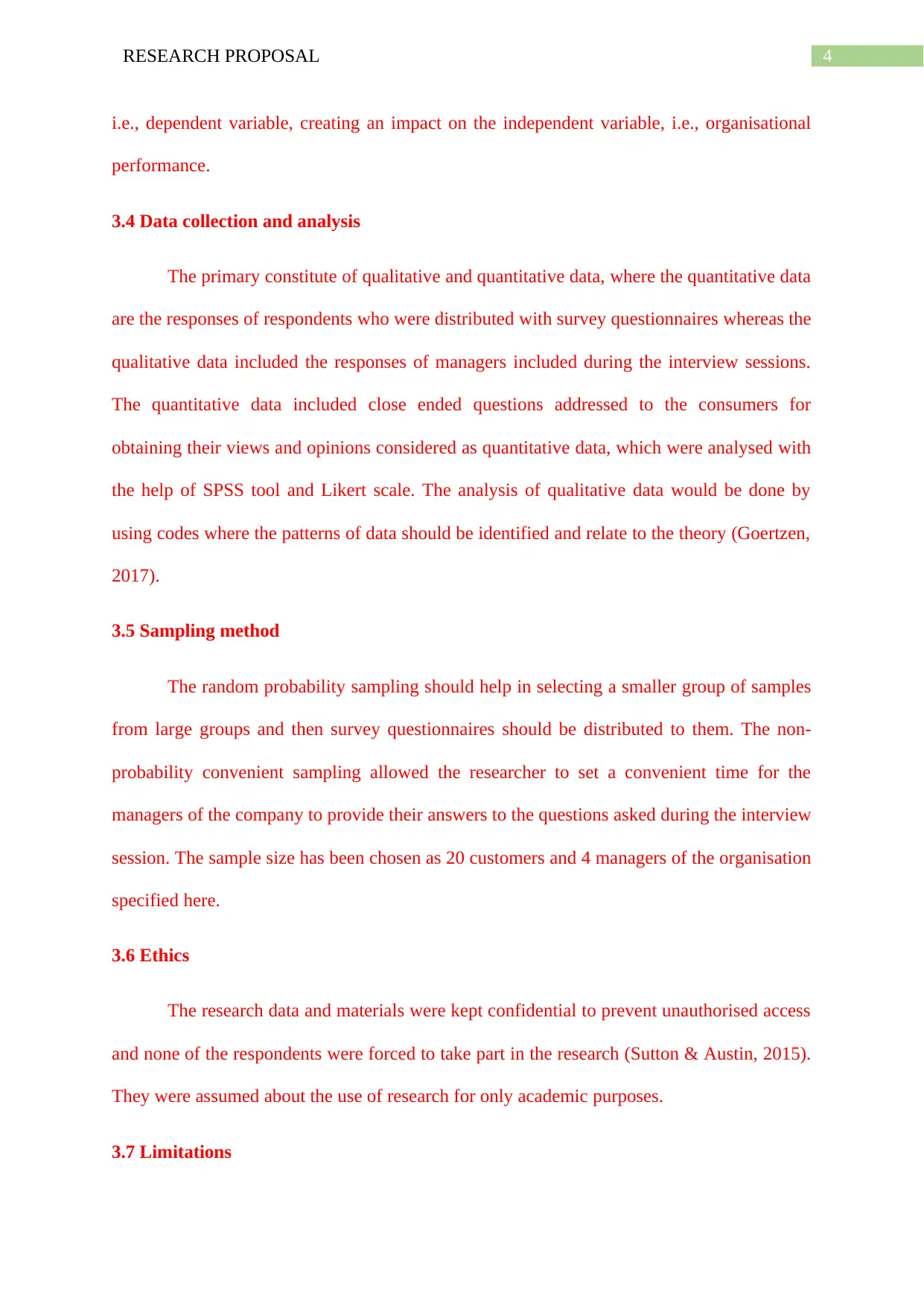
4RESEARCH PROPOSAL
i.e., dependent variable, creating an impact on the independent variable, i.e., organisational
performance.
3.4 Data collection and analysis
The primary constitute of qualitative and quantitative data, where the quantitative data
are the responses of respondents who were distributed with survey questionnaires whereas the
qualitative data included the responses of managers included during the interview sessions.
The quantitative data included close ended questions addressed to the consumers for
obtaining their views and opinions considered as quantitative data, which were analysed with
the help of SPSS tool and Likert scale. The analysis of qualitative data would be done by
using codes where the patterns of data should be identified and relate to the theory (Goertzen,
2017).
3.5 Sampling method
The random probability sampling should help in selecting a smaller group of samples
from large groups and then survey questionnaires should be distributed to them. The non-
probability convenient sampling allowed the researcher to set a convenient time for the
managers of the company to provide their answers to the questions asked during the interview
session. The sample size has been chosen as 20 customers and 4 managers of the organisation
specified here.
3.6 Ethics
The research data and materials were kept confidential to prevent unauthorised access
and none of the respondents were forced to take part in the research (Sutton & Austin, 2015).
They were assumed about the use of research for only academic purposes.
3.7 Limitations
i.e., dependent variable, creating an impact on the independent variable, i.e., organisational
performance.
3.4 Data collection and analysis
The primary constitute of qualitative and quantitative data, where the quantitative data
are the responses of respondents who were distributed with survey questionnaires whereas the
qualitative data included the responses of managers included during the interview sessions.
The quantitative data included close ended questions addressed to the consumers for
obtaining their views and opinions considered as quantitative data, which were analysed with
the help of SPSS tool and Likert scale. The analysis of qualitative data would be done by
using codes where the patterns of data should be identified and relate to the theory (Goertzen,
2017).
3.5 Sampling method
The random probability sampling should help in selecting a smaller group of samples
from large groups and then survey questionnaires should be distributed to them. The non-
probability convenient sampling allowed the researcher to set a convenient time for the
managers of the company to provide their answers to the questions asked during the interview
session. The sample size has been chosen as 20 customers and 4 managers of the organisation
specified here.
3.6 Ethics
The research data and materials were kept confidential to prevent unauthorised access
and none of the respondents were forced to take part in the research (Sutton & Austin, 2015).
They were assumed about the use of research for only academic purposes.
3.7 Limitations
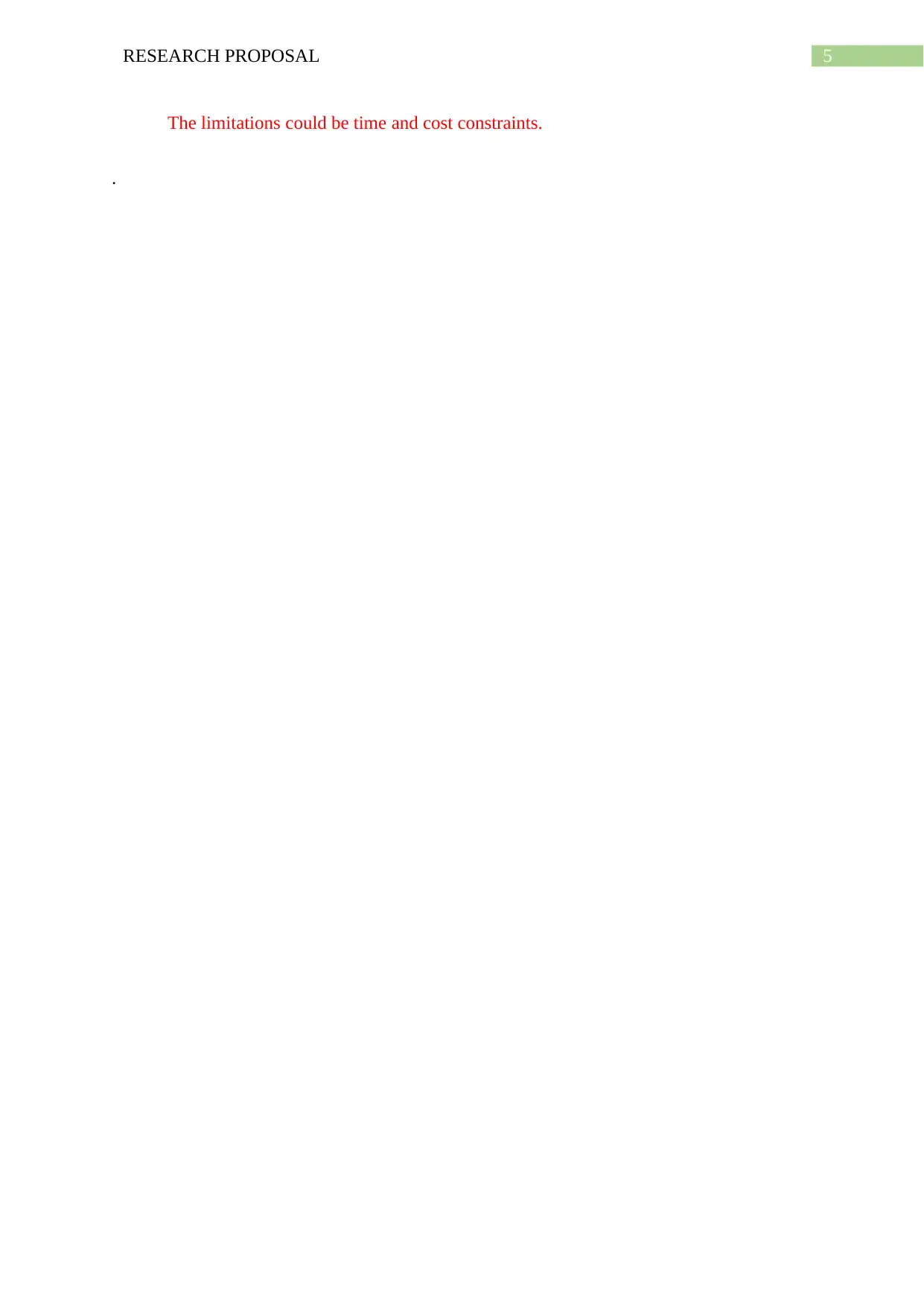
5RESEARCH PROPOSAL
The limitations could be time and cost constraints.
.
The limitations could be time and cost constraints.
.
⊘ This is a preview!⊘
Do you want full access?
Subscribe today to unlock all pages.

Trusted by 1+ million students worldwide
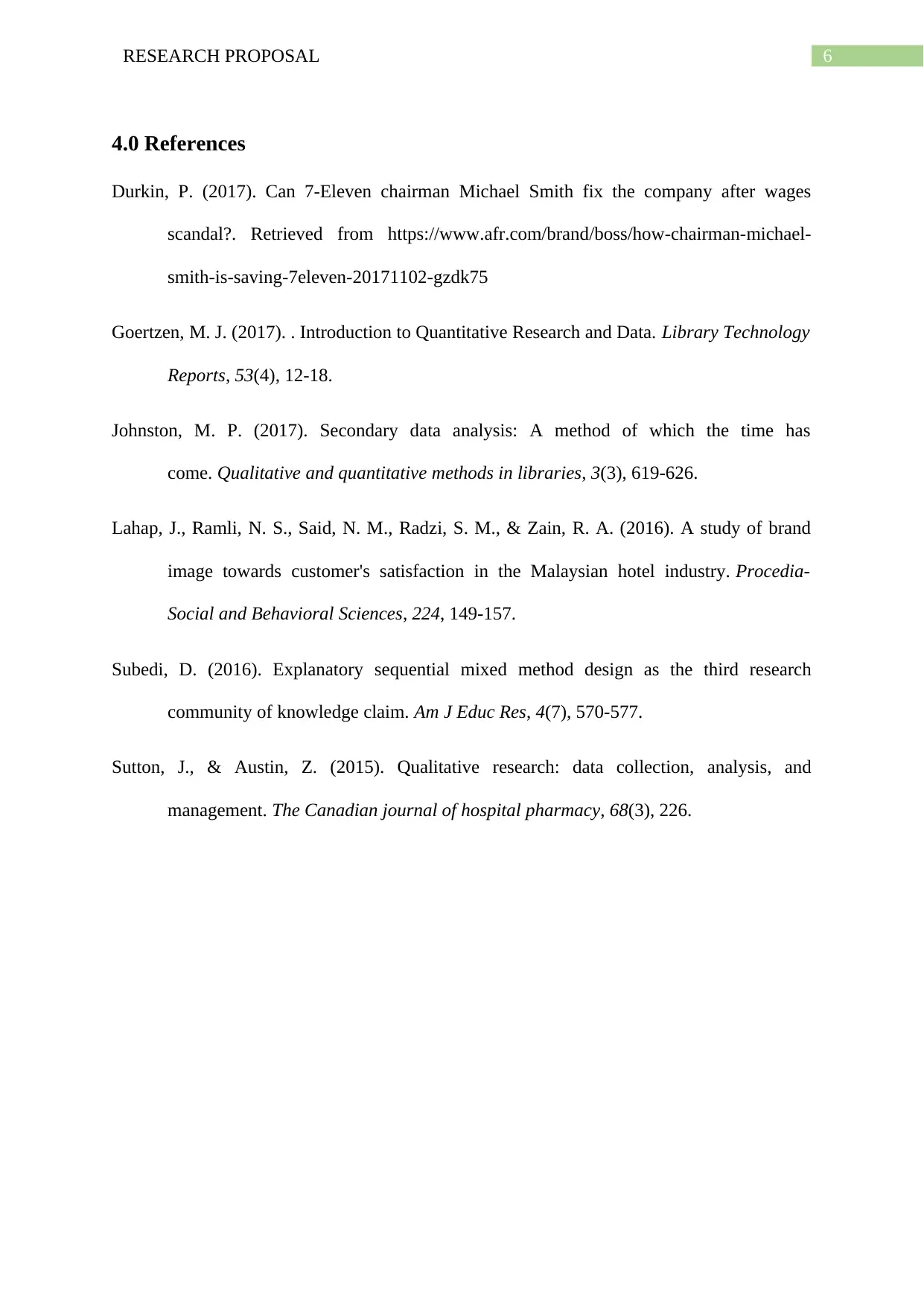
6RESEARCH PROPOSAL
4.0 References
Durkin, P. (2017). Can 7-Eleven chairman Michael Smith fix the company after wages
scandal?. Retrieved from https://www.afr.com/brand/boss/how-chairman-michael-
smith-is-saving-7eleven-20171102-gzdk75
Goertzen, M. J. (2017). . Introduction to Quantitative Research and Data. Library Technology
Reports, 53(4), 12-18.
Johnston, M. P. (2017). Secondary data analysis: A method of which the time has
come. Qualitative and quantitative methods in libraries, 3(3), 619-626.
Lahap, J., Ramli, N. S., Said, N. M., Radzi, S. M., & Zain, R. A. (2016). A study of brand
image towards customer's satisfaction in the Malaysian hotel industry. Procedia-
Social and Behavioral Sciences, 224, 149-157.
Subedi, D. (2016). Explanatory sequential mixed method design as the third research
community of knowledge claim. Am J Educ Res, 4(7), 570-577.
Sutton, J., & Austin, Z. (2015). Qualitative research: data collection, analysis, and
management. The Canadian journal of hospital pharmacy, 68(3), 226.
4.0 References
Durkin, P. (2017). Can 7-Eleven chairman Michael Smith fix the company after wages
scandal?. Retrieved from https://www.afr.com/brand/boss/how-chairman-michael-
smith-is-saving-7eleven-20171102-gzdk75
Goertzen, M. J. (2017). . Introduction to Quantitative Research and Data. Library Technology
Reports, 53(4), 12-18.
Johnston, M. P. (2017). Secondary data analysis: A method of which the time has
come. Qualitative and quantitative methods in libraries, 3(3), 619-626.
Lahap, J., Ramli, N. S., Said, N. M., Radzi, S. M., & Zain, R. A. (2016). A study of brand
image towards customer's satisfaction in the Malaysian hotel industry. Procedia-
Social and Behavioral Sciences, 224, 149-157.
Subedi, D. (2016). Explanatory sequential mixed method design as the third research
community of knowledge claim. Am J Educ Res, 4(7), 570-577.
Sutton, J., & Austin, Z. (2015). Qualitative research: data collection, analysis, and
management. The Canadian journal of hospital pharmacy, 68(3), 226.
1 out of 7
Related Documents
Your All-in-One AI-Powered Toolkit for Academic Success.
+13062052269
info@desklib.com
Available 24*7 on WhatsApp / Email
![[object Object]](/_next/static/media/star-bottom.7253800d.svg)
Unlock your academic potential
Copyright © 2020–2025 A2Z Services. All Rights Reserved. Developed and managed by ZUCOL.




